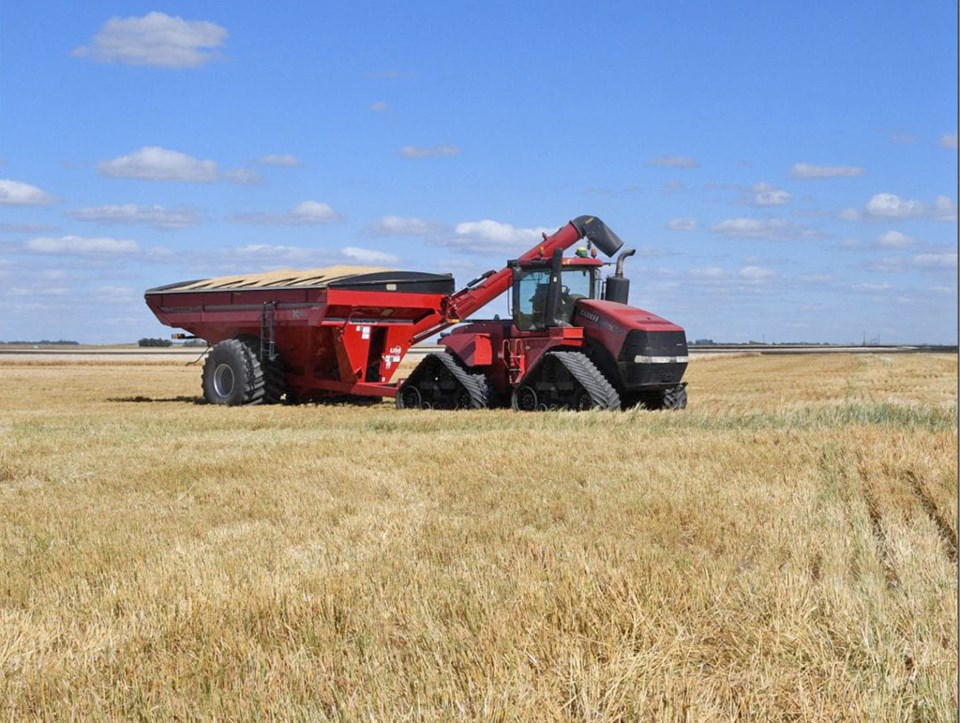Crop District 9AW – Crop Report for Sept. 7- 13 for the Shellbrook, North Battleford, Big River and Hafford areas:
Harvest was delayed a few days due to some scattered rain showers but producers were still able to make very good progress. Fifty-seven per cent of the crop has been combined, up from 37 per cent last week and well ahead of the five-year (2016-2020) average for this time of year of 19 per cent. An additional 35 per cent of the crop is swathed or ready to straight-cut. Producers are hoping for warm, dry conditions for the remainder of harvest.
Rainfall was spotty throughout the region this week. The North Battleford area received the highest amount of rain this week with 15 mm. The Neilburg area received 9.5 mm, the St. Walburg area nine mm, the Frenchman Butte, Lloydminster and Barthel areas all received seven mm and the Mayfair area five mm.
Much of the crop is coming off tough and damp and needing to be dried. Cropland topsoil moisture is rated as 27 per cent adequate, 35 per cent short and 38 per cent very short. Hay and pasture land topsoil moisture is rated as 16 per cent adequate, 34 per cent short and 50 per cent very short.
Pea grades are estimated as 27 per cent 1 CAN, 49 per cent 2 CAN, 24 per cent 3 CAN.
The majority of crop damage past week was due to frost in the Mayfair area, wind and wildlife.
Producers are busy combining, swathing, grain drying and moving bales.
Producers continued to make quick progress in their harvest operations this week. Seventy-four per cent of the crop has been combined, up from 56 per cent last week and well ahead of the five-year (2016-2020) average of 50 per cent for this time of year. An additional 17 per cent of the crop is swathed or ready to straight-cut. Warm and dry weather is desired to continue drying down crops and allow harvest to continue without delay.
Harvest is most advanced in the southwest region, where 85 per cent of the crop is in the bin. The southeast has 81 per cent combined, the west-central 79 per cent, the east-central 63 per cent, the northeast 69 per cent and the northwest 57 per cent.
Ninety-nine per cent of lentils, 98 per cent of field peas, 86 per cent of mustard, 82 per cent of barley, 89 per cent of durum, 83 per cent of spring wheat, 54 per cent of canola and 25 per cent of flax has now been combined. An additional 34 per cent of canola is swathed or ready to straight-cut.
Durum grades are being estimated as 27 per cent 1 CW, 34 per cent 2 CW, 28 per cent 3 CW and eleven per cent 4 and 5 CW. Pea grades are estimated as 25 per cent 1 CAN, 62 per cent 2 CAN, 12 per cent 3 CAN and one per cent Sample grade. Lentil grades are estimated to be 20 per cent 1 CAN, 62 per cent 2 CAN, 15 per cent 3 CAN and three per cent Sample grade.
Little rainfall
Most of the province received very little to no rainfall this week. The Shaunavon and Gull Lake areas received the highest amount of rain with 15 mm. Topsoil moisture conditions in the province continue to deteriorate due to strong winds and minimal rainfall. Cropland topsoil moisture is rated as 36 per cent adequate, 38 per cent short and 26 per cent very short. Hay and pasture land topsoil moisture is rated as 21 per cent adequate, 44 per cent short and 35 per cent very short.
The majority of crop damage this week was due to hail, wind and dry conditions. Frost was recorded in one RM in the northwest region; damage will vary depending on the temperature and duration of the frost as well as the stage of the crop. At this point in the season, the damage will likely be minimal as most crops are matured enough to withstand a minimal frost. Wind has continued to blow swaths and shell out crops. There were also reports of damage caused by wildlife and waterfowl.
Producers are busy combining, swathing, hauling bales and moving cattle. Post-harvest activities are well underway where harvest has finished up and producers hope the weather holds out so that fall herbicide and fertilizer applications can be carried out without issue.
With harvest underway in Saskatchewan, we want to remind producers to exercise caution and remain safe.
AgriRecovery accepting applications
As of September 1, the AgriRecovery program, now referred to as the 2021 Canada-Saskatchewan Drought Response Initiative, is accepting producer applications. The initiative will consist of two payments totaling up to $200/head for cattle, with adjustments based on animal unit equivalents for other livestock. The initial payment will provide producers with $100 per breeding female equivalent in inventory as of August 1, 2021. Secondary payments of up to $100 per breeding female in inventory as of December 31, 2021, will be made to producers who have incurred additional costs to retain the animals. Producers with questions can call the initiative's dedicated toll-free number at 1-844-723-1211 or directly by email.
We would like to also remind producers that the Farm Stress Line is available for support if you need it. It is a confidential service, available 24-hours-a-day, seven-days-a-week, toll-free at 1-800-667-4442. Calls are answered by Mobile Crisis Services Regina, a non-profit, community-based agency and there is no call display.
A complete, printable version of the Crop Report is available online at https://www.saskatchewan.ca/crop-report
Follow the 2021 Crop Report on Twitter at @SKAgriculture.




